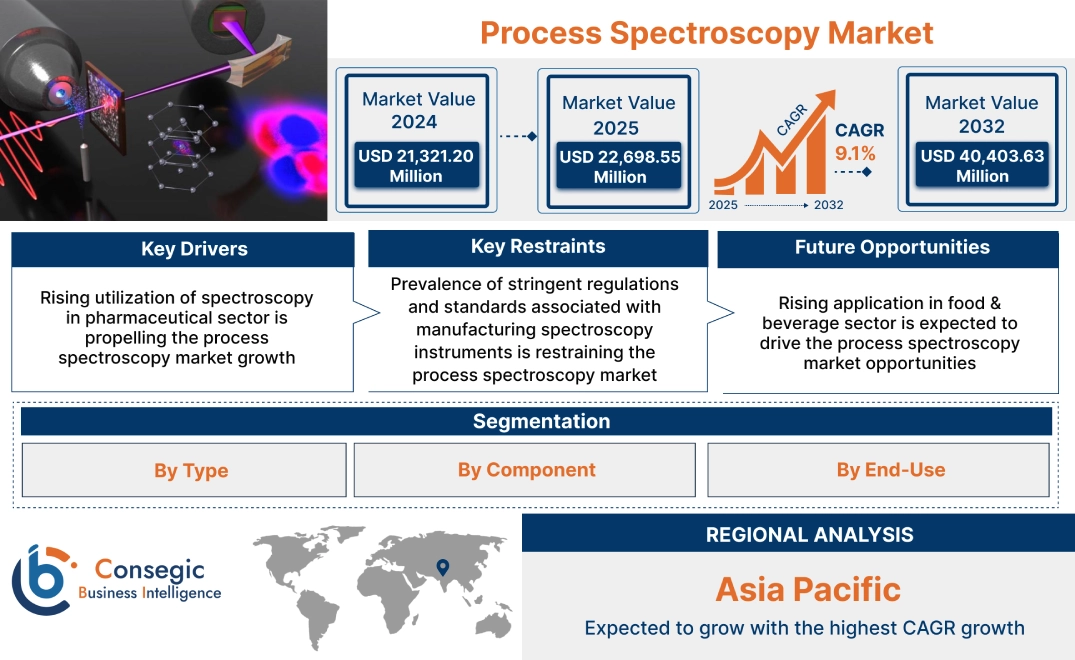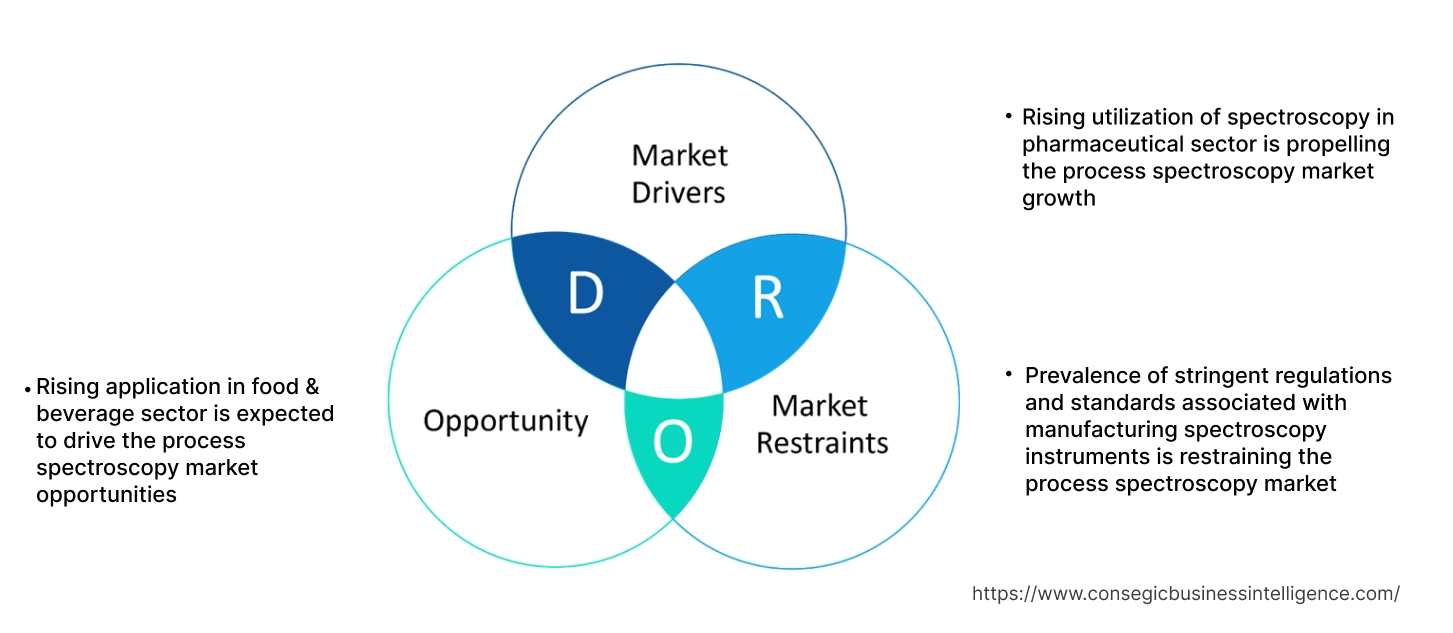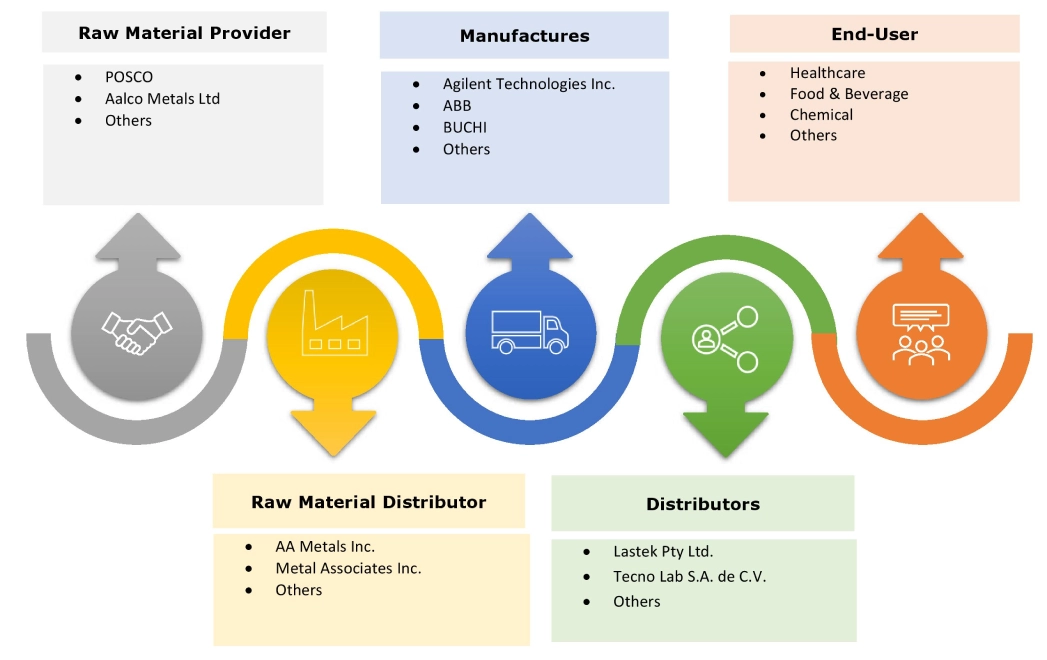- Summary
- Table Of Content
- Methodology
Process Spectroscopy Market Size:
Process Spectroscopy Market size is estimated to reach over USD 40,403.63 Million by 2032 from a value of USD 21,321.20 Million in 2024 and is projected to grow by USD 22,698.55 Million in 2025, growing at a CAGR of 9.1% from 2025 to 2032.
Process Spectroscopy Market Scope & Overview:
Process spectroscopy involves the study of emission and absorption of light and other radiations by matter. Spectroscopy also deals with interactions among particles such as electrons, protons, and ions. It involves the use of light (usually in visible, infrared, or ultraviolet spectrum) for attaining information regarding molecular composition, structure, and interactions of substances involved in a process. Moreover, process spectroscopy offer a range of benefits such as real-time process monitoring, comprehensive data collection, quality control, process optimization, and enhanced efficiency among others. The aforementioned benefits of spectroscopy are key determinants for increasing its utilization in healthcare & life science, food & beverage, chemical, oil & gas, paper & pulp, semiconductor, and other industries.
Key Drivers:
Rising utilization of spectroscopy in pharmaceutical sector is propelling the process spectroscopy market growth
Process spectroscopy is used in the pharmaceutical sector, particularly in the development of pharmaceuticals for examining drug crystalline structures, drug identity and purity, interactions between active ingredients and excipients, and other related applications. Moreover, spectroscopy plays a crucial role in providing valuable information associated with the levels of active ingredients present in pharmaceutical compounds, along with detecting impurities. Additionally, the use of spectroscopy in pharmaceutical drug development and production processes offers several benefits such as improved drug characterization, enhanced quality control and assurance, real-time in-process monitoring, and others, which are primary determinants for increasing in its utilization in pharmaceutical sector.
- For instance, according to the European Federation of Pharmaceutical Industries and Associations (EFPIA), the total production of pharmaceutical sector in Europe was valued at USD 430.42 billion in 2023, witnessing an increase of 7.3% in comparison to USD 400.95 billion in 2022.
Hence, the rising pharmaceutical production is further driving the utilization of spectroscopy during pharmaceutical drug development and production processes, in turn proliferating the process spectroscopy market size.
Key Restraints:
Prevalence of stringent regulations and standards associated with manufacturing spectroscopy instruments is restraining the process spectroscopy market
Spectroscopy instruments are used in a various industries including pharmaceutical, chemical, food & beverage, and others. However, spectroscopy instrument manufacturers have to comply with numerous stringent standards associated with production of spectroscopy instruments, which is a prime factor restricting the market growth.
For instance, spectroscopy instrument manufacturers have to comply with various standards such as European Pharmacopoeia, United States Pharmacopeia (USP<857>) ISO (International Organization for Standardization) standard, and others.
Additionally, United States Pharmacopeia - USP <857> requires the precision of ultraviolet–visible instruments including spectrometers to be over 0.5 nm across the operating range of the instrument. Therefore, the prevalence of the aforementioned standards associated with manufacturing spectroscopy instruments is hindering the process spectroscopy market expansion.
Future Opportunities :
Rising application in food & beverage sector is expected to drive the process spectroscopy market opportunities
Spectroscopy instruments are often utilized in food & beverage sector for testing of food and beverage products to ensure optimal quality and safety. Spectroscopy instruments are used during food & beverage manufacturing for analyzing the quality and safety of all raw ingredients, process intermediates, along with final products. Moreover, spectroscopy instruments are also used for tracking contamination in food & beverage products, which in turn minimizing adulteration, and confirming product consistency. Additionally, spectroscopy instruments are typically used in food & beverage manufacturing for facilitating improved real-time process monitoring and quality control, microbial monitoring, health and safety compliance, and others.
- For instance, according to Food Drink Europe, the European Union food and beverage sector was valued at EUR 1,121 billion (USD 1,196.7 billion) in 2022, demonstrating an incline of 2.6% in comparison to EUR 1,093 billion (USD 1,166.8 billion) in 2021.
Hence, as per the analysis, the growing food & beverage sector is anticipated to increase the adoption of spectroscopy for testing of food and beverage products to ensure optimum quality and safety. The above factors are further projected to boost the process spectroscopy market opportunities during the forecast period.
Process Spectroscopy Market Segmental Analysis :
By Type:
Based on type, the market is segmented into infrared (IR) spectroscopy, ultraviolet-visible (UV/Vis) spectroscopy, nuclear magnetic resonance (NMR) spectroscopy, raman spectroscopy, x-ray spectroscopy, and others.
Trends in the type:
- Increasing trend in adoption of infrared spectroscopy due to its high sensitivity, rapid examination, and non-destructive testing among others.
- There is a rising trend towards utilization of nuclear magnetic resonance (NMR) spectroscopy for advanced molecular and structural biology applications among others.
Infrared (IR) spectroscopy segment accounted for a significant revenue share in the overall market in 2024.
- Infrared spectroscopy is used for measuring the interaction of infrared radiation with matter.
- Infrared spectroscopy is primarily utilized for identifying and characterizing organic compounds based on the absorption of IR light by molecular vibrations.
- Moreover, infrared spectroscopy provides a range of benefits such as high sensitivity, rapid analysis, non-destructive testing, molecular identification, versatility in applications, and others.
- For instance, in March 2023, Edinburgh Instruments launched its new IR5 model of FTIR spectrometer, which is an infrared spectrometer that features including high sensitivity and improved spectral resolution. It is ideal for use in most demanding research applications.
- According to the process spectroscopy market analysis, the rising advancements associated with infrared spectroscopy are driving the process spectroscopy market trends.
Nuclear magnetic resonance (NMR) spectroscopy segment is anticipated to register substantial CAGR growth during the forecast period.
- Nuclear magnetic resonance (NMR) spectroscopy involves exploiting the magnetic properties of certain atomic nuclei.
- In NMR spectroscopy, nuclei of atoms are usually placed in a strong magnetic field and subjected to radio frequency radiation. These nuclei absorb energy and further resonate at particular frequencies, which are detected and transformed into a spectrum. The resulting spectrum offers detailed information related to the structure and dynamics of the molecules within a sample.
- For instance, in February 2023, Bruker announced successful customer installations of its two compact 1.0 GHz NMR spectrometers. The NMR spectrometers was integrated for advanced molecular and structural biology applications.
- Thus, the increasing adoption of NMR spectrometers is anticipated to propel the market during the forecast period.
By Component:
Based on component, the market is segmented into hardware, software, and services.
Trends in the component:
- Increasing advancements associated with spectroscopy instruments including such as infrared (IR) spectrometers, nuclear magnetic resonance (NMR) spectrometers, and others.
- There is a rising trend towards utilization of spectroscopy software, attributing to its benefits such as consistent data acquisition and processing, real-time monitoring, advanced analytical capabilities, and others.
Hardware segment accounted for the largest revenue share of 59.52% in the total process spectroscopy market share in 2024.
- The primary hardware components used in process spectroscopy include spectrometers, light source, detectors, optical components, and others.
- Moreover, different spectroscopy techniques utilize various light sources, such as lasers, infrared sources, and others. Optical components are used for manipulating and directing the light within the system while ensuring optimal interaction with the sample.
- For instance, in November 2022, Bruker launched its new MOBILE-IR II model of portable fourier transform infrared (FT-IR) spectrometer that offers high spectral performance.
- Therefore, increasing advancements associated with spectrometers are driving the process spectroscopy market growth.
Software segment is anticipated to register a significant CAGR growth during the forecast period.
- Spectroscopy software is primarily used for acquisition, interpretation, analytics, and visualization of spectroscopic data generated by several types of spectrometers.
- The primary functionalities of spectroscopy software includes data acquisition, data processing, spectral analysis, calibration, data visualization, and others.
- For instance, StellarNet Inc. offers a range of spectroscopy software in its solution offerings, which provides basic spectral acquisition to full spectroscopy programs such as spectral absorbance, reflectance, transmittance, radiometry, emissions, and others.
- Hence, the rising advancements related to spectroscopy software is anticipated to boost the process spectroscopy market size during the forecast period.
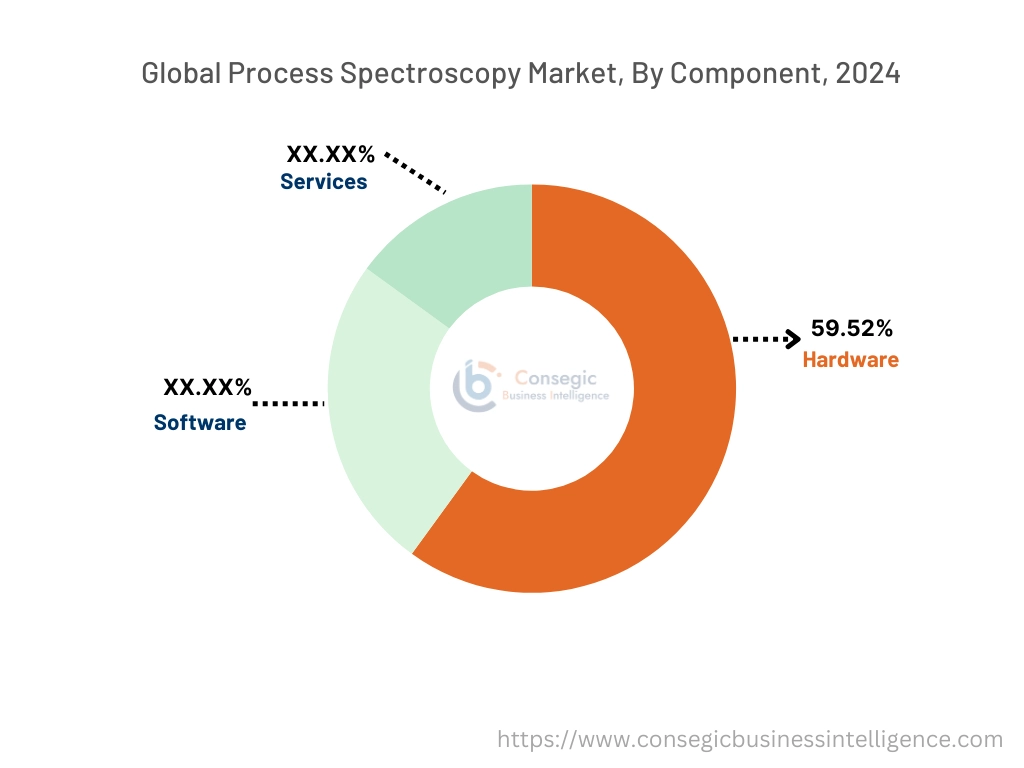
By End-Use:
Based on the end-use, the market is segmented into healthcare & life science, food & beverage, chemical, oil & gas, paper & pulp, semiconductor, and others.
Trends in the end-use:
- Rising trend towards adoption of spectrometers during drug formulation and production processes along with biomedical research and development activities.
- Increasing adoption of spectroscopy in food & beverage sector for testing of food and beverage products to ensure optimal quality and safety.
Healthcare & life science segment accounted for the largest revenue in the overall process spectroscopy market share in 2024.
- Spectroscopy is used in healthcare & life science sector, particularly in the development of pharmaceuticals for examining drug crystalline structures, interactions between active ingredients and excipients, drug identity and purity, and other related applications.
- Additionally, the utilization of spectroscopy in drug formulation and production processes offers several benefits such as improved drug characterization, real-time in-process monitoring, enhanced quality control and assurance, and others.
- For instance, according to the European Federation of Pharmaceutical Industries and Associations, the total pharmaceutical production Germany was valued at USD 10,004.50 million in 2022.
- According to the analysis, the increasing pharmaceutical production is driving the adoption of spectroscopy instruments, in turn propelling the market growth.
Food & beverage segment is anticipated to register a substantial CAGR growth during the forecast period.
- Spectroscopy instruments are often utilized in food & beverage industry for testing of food and beverage products to ensure optimal quality and safety.
- Moreover, spectroscopy instruments are typically used in food & beverage manufacturing for facilitating improved real-time process monitoring and quality control, microbial monitoring, health and safety compliance, and others.
- Spectroscopy instruments are used during food & beverage manufacturing for analyzing the quality and safety of all raw ingredients, process intermediates, along with final products.
- For instance, Kerry Group, a food and beverage company, announced the launch of its new food manufacturing facility in Georgia, United States in 2022. The food manufacturing facility was developed to meet the rising consumer demand in seafood, poultry, and alternative protein markets across the United States and Canada.
- Thus, the rising development of food & beverage manufacturing facilities is projected to drive the market during the forecast period.
Regional Analysis:
The regions covered are North America, Europe, Asia Pacific, the Middle East and Africa, and Latin America.
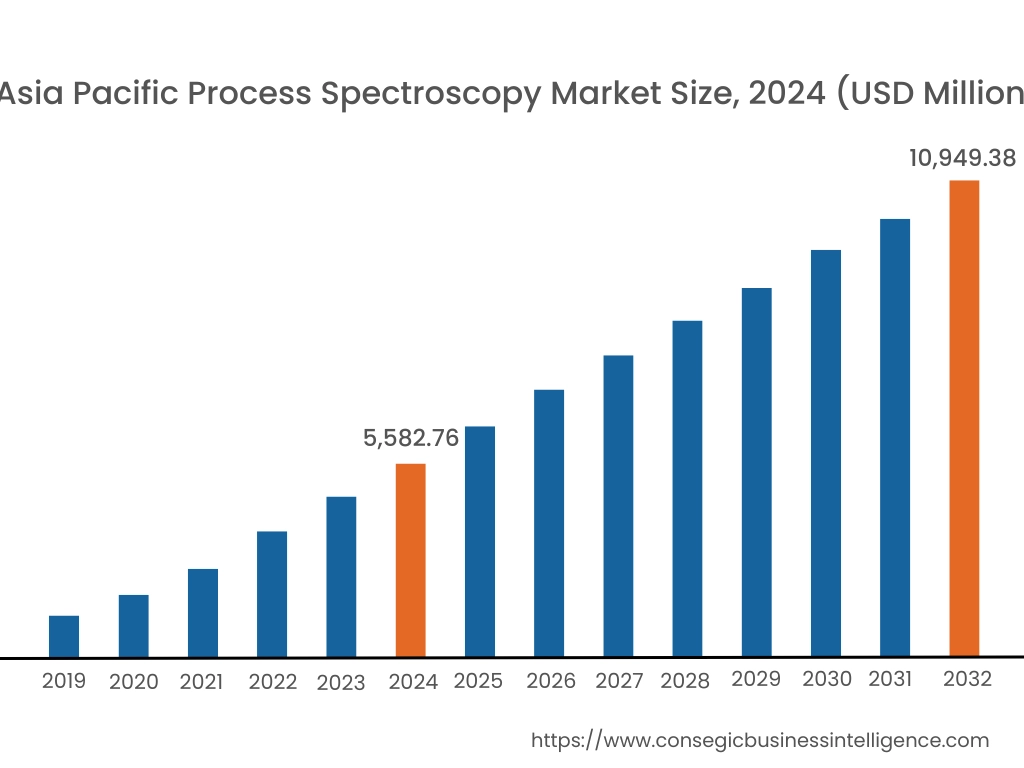
Asia Pacific region was valued at USD 5,582.76 Million in 2024. Moreover, it is projected to grow by USD 5,960.73 Million in 2025 and reach over USD 10,949.38 Million by 2032. Out of this, China accounted for the maximum revenue share of 33.5%. As per the process spectroscopy market analysis, the adoption of spectroscopy in the Asia-Pacific region is primarily driven by growing healthcare, paper & pulp, and semiconductor sectors among others. Additionally, the rising adoption of spectroscopy during pharmaceutical production is further accelerating the process spectroscopy market expansion.
- For instance, according to the India Brand Equity Foundation, the local pharmaceutical sector in India consist of approximately 3,000 drug companies and 10,500 pharmaceutical manufacturing units. The above factors are further driving the adoption of spectroscopy instruments during pharmaceutical manufacturing, in turn propelling the market in the Asia-Pacific region.
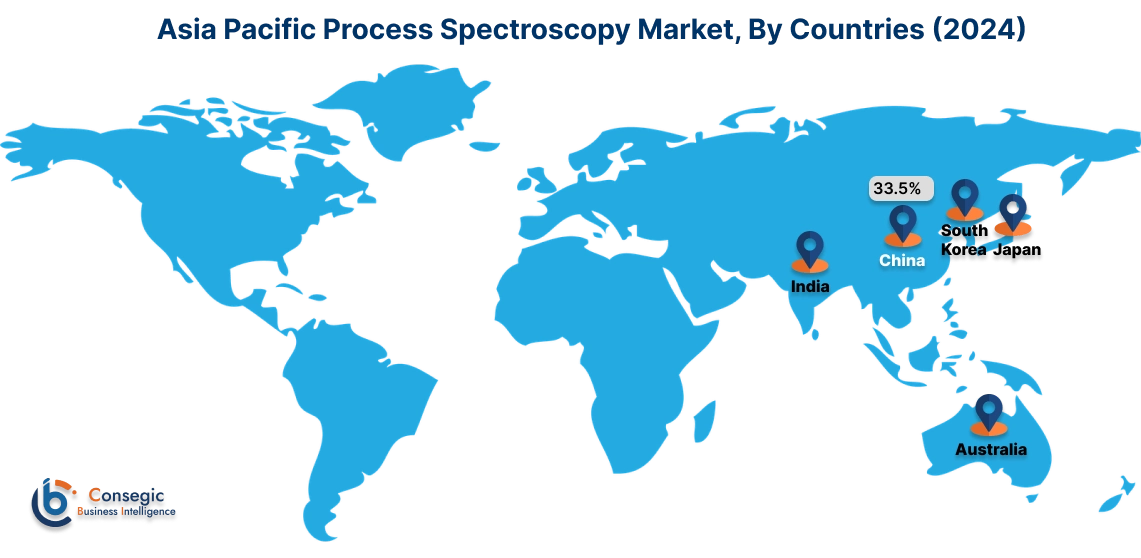
North America is estimated to reach over USD 14,315.00 Million by 2032 from a value of USD 7,552.31 Million in 2024 and is projected to grow by USD 8,040.35 Million in 2025.
In North America, the growth of process spectroscopy industry is driven by rising investments in food & beverage, chemical, and other sectors. Similarly, the rising investments in development of chemical manufacturing facilities and increasing utilization of spectroscopy for chemical examination to determine the chemical characteristics and purity of substances are further contributing to the process spectroscopy market demand.
- For instance, in November 2023, Evonik, a global specialty chemicals company, announced the development of a new chemical manufacturing plant for producing ultra-high purity colloidal silica at its site in Michigan, United States. The above factors are projected to drive the process spectroscopy market trends in North America during the forecast period.
Additionally, the regional analysis depicts that the growing chemical, food & beverage, and paper & pulp sectors is driving the process spectroscopy market demand in Europe. Furthermore, as per the market analysis, the market demand in Latin America, Middle East, and African regions is expected to grow at a considerable rate due to factors such as rising pace of industrialization and increasing adoption of spectroscopy solutions in food & beverage, healthcare, and chemical sectors among others.
Top Key Players and Market Share Insights:
The global process spectroscopy market is highly competitive with major players providing products to the national and international markets. Key players are adopting several strategies in research and development (R&D), product innovation, and end-user launches to hold a strong position in the process spectroscopy market. Key players in the process spectroscopy industry include-
- Agilent Technologies Inc. (U.S)
- ABB (Switzerland)
- BUCHI (Switzerland)
- Bruker Corporation (U.S)
- Danaher Corporation (U.S)
- HORIBA Ltd. (Japan)
- Shimadzu Corporation (Japan)
- Sartorius AG (Germany)
- Thermo Fisher Scientific Inc. (U.S)
- Yokogawa Electric Corporation (Japan)
Recent Industry Developments :
Product Launch:
- In November 2022, Bruker launched its new MOBILE-IR II model of portable fourier transform infrared (FT-IR) spectrometer that offers high spectral performance.
- In April 2022, Thermo Fisher Scientific Inc. introduced its Raman spectroscopic analyzer that is designed for process monitoring for various applications, including biopharmaceutical manufacturing. The spectroscopic analyzer offers non-destructive and continuous analytics along with rapid system setup and deployment.
Process Spectroscopy Market Report Insights :
| Report Attributes | Report Details |
| Study Timeline | 2018-2032 |
| Market Size in 2032 | USD 40,403.63 Million |
| CAGR (2025-2032) | 9.1% |
| By Type |
|
| By Component |
|
| By End-Use |
|
| By Region |
|
| Key Players |
|
| North America | U.S. Canada Mexico |
| Europe | U.K. Germany France Spain Italy Russia Benelux Rest of Europe |
| APAC | China South Korea Japan India Australia ASEAN Rest of Asia-Pacific |
| Middle East and Africa | GCC Turkey South Africa Rest of MEA |
| LATAM | Brazil Argentina Chile Rest of LATAM |
| Report Coverage |
|
Key Questions Answered in the Report
How big is the process spectroscopy market? +
The process spectroscopy market was valued at USD 21,321.20 Million in 2024 and is projected to grow to USD 40,403.63 Million by 2032.
Which is the fastest-growing region in the process spectroscopy market? +
Asia-Pacific is the region experiencing the most rapid growth in the process spectroscopy market.
What specific segmentation details are covered in the process spectroscopy report? +
The process spectroscopy report includes specific segmentation details for type, component, end-use, and region.
Who are the major players in the process spectroscopy market? +
The key participants in the process spectroscopy market are Agilent Technologies Inc. (U.S), ABB (Switzerland), BUCHI (Switzerland), Bruker Corporation (U.S), Danaher Corporation (U.S), HORIBA Ltd. (Japan), Shimadzu Corporation (Japan), Sartorius AG (Germany), Thermo Fisher Scientific Inc. (U.S), Yokogawa Electric Corporation (Japan), and others.
